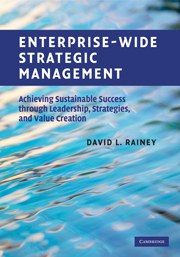 Enterprise-Wide Strategic Management
Enterprise-Wide Strategic Management from Part II - Strategic management: Formulation and implementation
Published online by Cambridge University Press: 05 June 2012
Introduction
The more specific and tangible aspects of enterprise-wide strategic management (ESM) involve the strategic management systems (SMSs) of business units. The strategic business units (SBUs) translate the vision and strategic direction of the company/corporation into executable missions, business strategies, action plans, and operating results. They focus on the market spaces, competitive landscapes, and specific business/product portfolios. Whereas corporate strategic leaders focus on crafting and implementing high-level, future-oriented grand strategies, SBU leaders manage the SMSs and concentrate on developing the game plans providing means and mechanisms necessary to take advantage of business opportunities and deal with challenges. They concentrate on achieving balanced and broad-based, near-term objectives and long-term sustainable success. SBU leaders play more specific roles in managing the affairs of the business units than corporate executives. They are responsibile for formulating and implementing business strategies and ensuring that functional and operational management performs in accordance with the strategic direction of the company and overall objectives.
For some companies, especially small and medium-sized enterprises (SMEs), the corporate level management system and the SMS are merged into a single, embedded system. Here, corporate executives also function in the roles of SBU leaders with narrower perspectives, well-targeted market spaces, and definitive product portfolios. In such cases, there may still be distinctions between corporate roles and responsibilities and those of the SBU leaders as articulated in this chapter. It is imperative that business leaders understand the differences and act accordingly.
To save this book to your Kindle, first ensure no-reply@cambridge.org is added to your Approved Personal Document E-mail List under your Personal Document Settings on the Manage Your Content and Devices page of your Amazon account. Then enter the ‘name’ part of your Kindle email address below. Find out more about saving to your Kindle.
Note you can select to save to either the @free.kindle.com or @kindle.com variations. ‘@free.kindle.com’ emails are free but can only be saved to your device when it is connected to wi-fi. ‘@kindle.com’ emails can be delivered even when you are not connected to wi-fi, but note that service fees apply.
Find out more about the Kindle Personal Document Service.
To save content items to your account, please confirm that you agree to abide by our usage policies. If this is the first time you use this feature, you will be asked to authorise Cambridge Core to connect with your account. Find out more about saving content to Dropbox.
To save content items to your account, please confirm that you agree to abide by our usage policies. If this is the first time you use this feature, you will be asked to authorise Cambridge Core to connect with your account. Find out more about saving content to Google Drive.